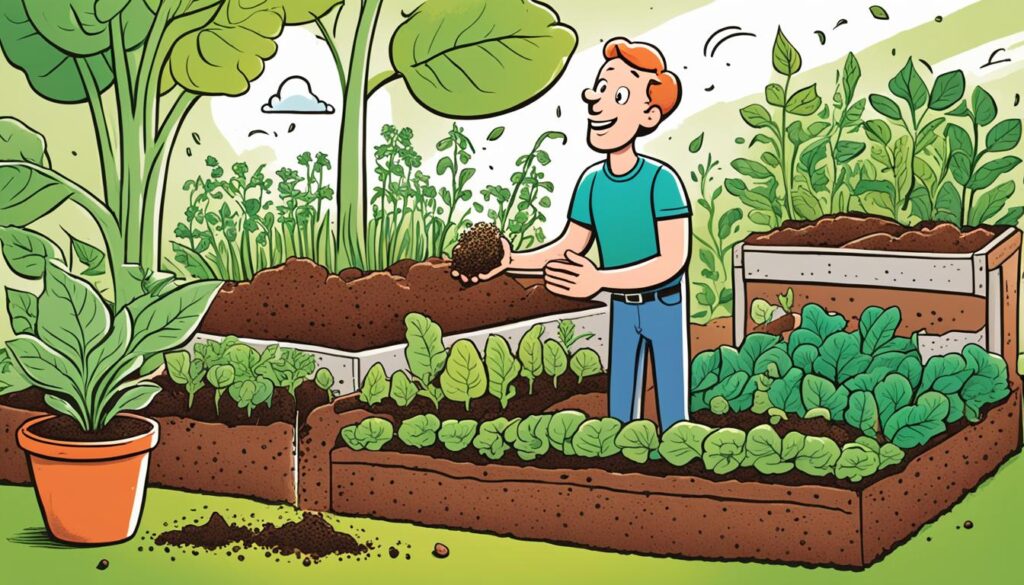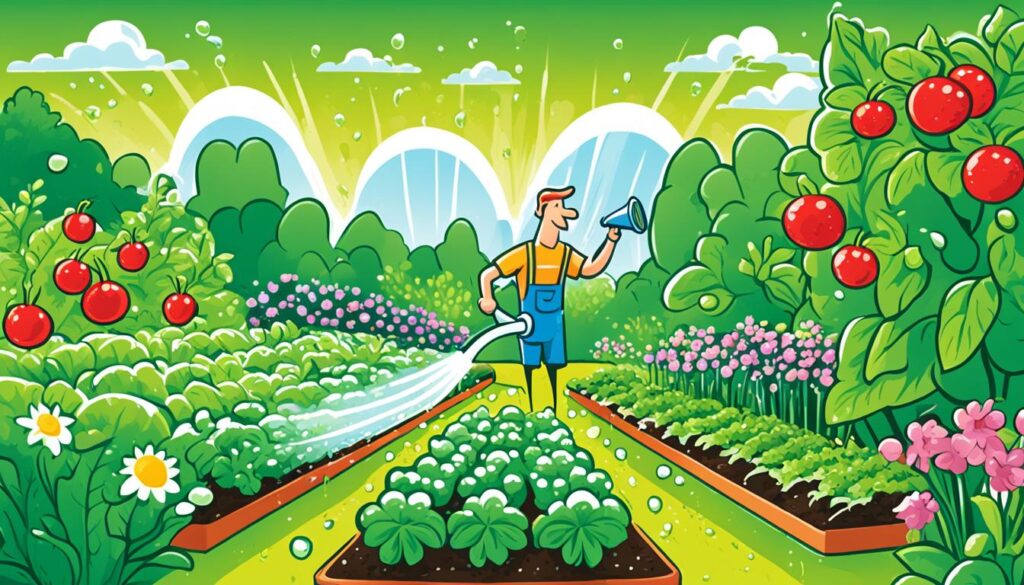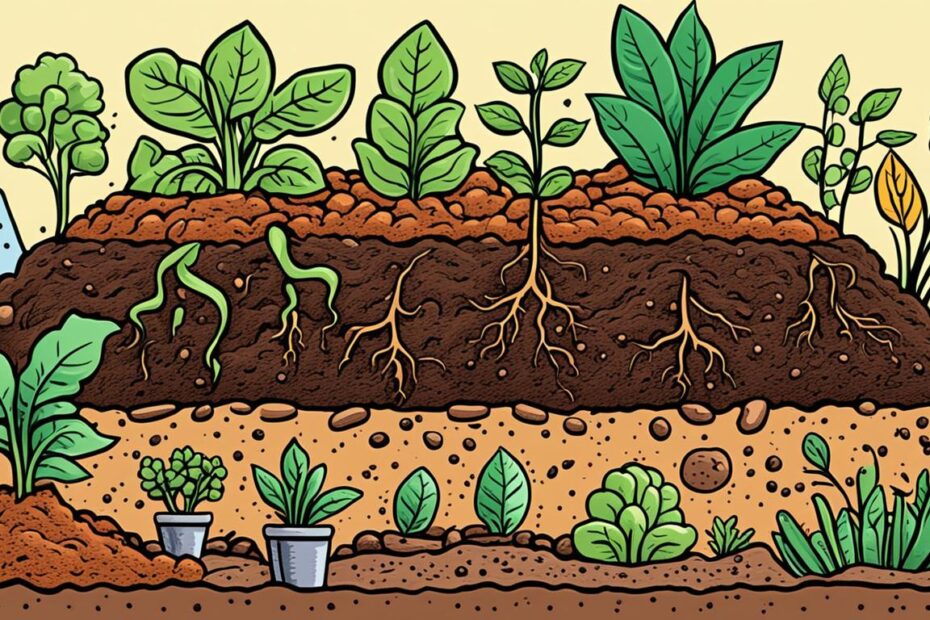Are you tired of relying on synthetic fertilizers that harm the environment and disrupt the delicate balance of your garden? Wondering if there’s a better way to nourish your plants while sustaining the earth? Look no further! In this article, we will explore the secrets of natural fertilization and discover eco-friendly methods that will transform your garden into a thriving oasis.
Key Takeaways:
- By utilizing organic alternatives, you can naturally fertilize soil and promote the health of your plants.
- Preparing the soil with the right nutrient balance and organic matter sets the foundation for successful gardening.
- Choosing the right type and ratio of organic fertilizers ensures nutrient absorption without causing harm or imbalance.
- Proper irrigation techniques and understanding light requirements contribute to the overall health and growth of your plants.
- By following eco-friendly practices, you can create a sustainable garden that flourishes with beauty and abundance.
The Foundation: Preparing the Soil
Preparing the soil is the first step towards a successful garden. It’s crucial to select the right soil for your plants, ensuring it has the perfect balance of nutrients. By conducting a soil test, you can determine the pH levels and nutrient content, guiding your preparation process. Enhancing the soil with organic matter, such as compost or aged manure, can significantly improve its structure and fertility. This organic matter provides essential nutrients for plant growth, creating an optimal environment for your garden to thrive.
When it comes to preparing the soil, proper soil selection is key. Different plants have specific soil requirements, and understanding these needs will lead to healthier and more productive growth. Whether you’re planting delicate flowers or robust vegetables, choosing the right soil type will ensure that your plants receive the necessary support to flourish.
Soil Testing for Optimal Nutrient Balance
Soil testing is a valuable tool in determining the nutrient balance of your soil. By analyzing the pH levels and nutrient content, you can identify any deficiencies or excesses that may hinder plant growth. This information allows you to make informed decisions about the types and quantities of fertilizers or amendments needed to achieve an optimal nutrient balance.
Incorporating organic matter into the soil is an effective way to enhance its fertility and structure. Compost and aged manure are rich sources of organic matter, providing essential nutrients and improving soil moisture retention. Mixing these organic materials into your soil will enhance its overall quality, promoting healthier root development and nutrient uptake for your plants.
Remember, preparing the soil is an ongoing process. Regularly testing and amending your soil ensures that it remains fertile and provides a nourishing environment for your plants to grow and thrive. Now, let’s take a look at how proper fertilization can further support the health and vitality of your garden.
| Soil Selection | Soil Testing | Nutrient Balance | Organic Matter |
|---|---|---|---|
| Choose the right soil type to meet the needs of your plants. | Conduct a soil test to determine pH levels and nutrient content. | Maintain an optimal nutrient balance for healthy plant growth. | Add organic matter such as compost or aged manure to improve soil structure and fertility. |
Feeding Your Garden: Fertilizing for Healthy Growth
Fertilization is the key to providing your garden with the necessary nutrients for healthy plant growth. Instead of relying on synthetic fertilizers, opt for organic alternatives that are not only beneficial for your plants but also environmentally friendly. By choosing the right type and ratio of organic fertilizers, you can maintain a nutrient balance that promotes optimal plant health.
Organic fertilizers, such as compost, bone meal, or seaweed extracts, are rich in nutrients and help enhance soil fertility. These natural fertilizers provide a slow and steady release of nutrients, ensuring a consistent supply for your plants without causing nutrient imbalances or harm to the environment.
Timing and dosage are crucial factors in ensuring effective fertilization. It’s important to understand the specific nutrient requirements of your plants at different stages of growth. Generally, it is recommended to fertilize your garden before planting, during the growing season, and as needed based on the nutritional needs of your plants.
When it comes to timing, it’s best to fertilize your garden in the spring, before the plants start actively growing. This helps provide the necessary nutrients for a strong start. Throughout the growing season, you can continue to fertilize every 4-6 weeks, depending on the specific requirements of your plants.
Pro Tip: Take the time to assess the nutrient needs of your plants. Understanding the timing and specific nutrient requirements of individual plants will help you tailor your fertilization schedule for optimal results.
When applying organic fertilizers, it’s important to follow the instructions on the packaging and avoid over-fertilization. Too much fertilizer can lead to nutrient imbalances, stunted growth, or even plant damage. Always measure and apply the fertilizer according to the recommended dosage to ensure that your plants are receiving the appropriate amount of nutrients.
Fertilizing your garden with organic fertilizers not only supports the growth and health of your plants but also contributes to the overall well-being of the ecosystem. Organic fertilizers improve soil quality, increase beneficial microbial activity, and help maintain a sustainable balance in your garden.
Now that you understand the importance of feeding your garden with organic fertilizers, let’s explore some additional tips and techniques for maintaining a healthy and thriving garden.

Benefits of Organic Fertilizers
Organic fertilizers offer numerous benefits for your garden:
- Promote soil health and fertility
- Provide essential nutrients for plant growth
- Enhance microbial activity and improve soil structure
- Reduce the risk of nutrient imbalances and environmental pollution
- Support the growth of beneficial organisms, such as earthworms and beneficial bacteria
By utilizing organic fertilizers, you not only nourish your plants but also contribute to the long-term sustainability of your garden.
Watering Wisely: The Art of Proper Irrigation
Proper irrigation is essential for the health and growth of your plants. To ensure your plants thrive, it’s important to water them wisely, taking into consideration their specific water requirements. Different plants have varying watering needs, so it’s crucial to establish a watering frequency based on their individual needs.
To determine the optimal watering frequency for your plants, consider factors such as the type of plant, soil type, weather conditions, and season. Some plants, like succulents, require infrequent watering, while others, like vegetables or annual flowers, have higher water requirements and may need more frequent watering.
It’s also important to develop a drainage plan to prevent water-related issues such as root rot. Ensure that your plants are not sitting in stagnant water, as it can lead to soggy soil and hinder root development. Adequate drainage will allow excess water to flow away from the roots, maintaining a healthy root environment.
When it comes to irrigation techniques, there are various methods you can use. Here are a few options:
- Drip irrigation: A system that delivers water directly to the plant’s root zone, minimizing water loss through evaporation. This method is efficient and helps conserve water.
- Sprinkler irrigation: Ideal for larger areas, sprinklers distribute water in a circular pattern. While it may not be as water-efficient as drip irrigation, it can be effective for evenly watering lawns or larger garden beds.
- Hand watering: Using a watering can or hose with a nozzle attachment, hand watering allows you to have more control over where and how much water is being applied. This method is especially useful for delicate plants or areas that require targeted watering.

Remember to water your plants during the early morning or late afternoon to minimize water loss due to evaporation. Avoid watering during the hottest part of the day to prevent scorching your plants and wasting water.
Proper irrigation keeps your plants healthy and hydrated, preventing moisture-related diseases and promoting optimal growth. Watering wisely is a crucial aspect of maintaining a thriving garden.
In summary, by understanding the specific water requirements of your plants, developing a drainage plan, and utilizing suitable irrigation techniques, you can provide your plants with the hydration they need. Consistent and appropriate irrigation will help your plants flourish and contribute to the success of your garden.
Sunshine and Shade: Understanding Light Requirements
Light is a vital factor in the growth and development of your plants. By understanding their specific light requirements, you can create the optimal conditions for their thriving. Some plants thrive in direct sunlight, while others prefer indirect light or shade. It’s crucial to assess the sunlight exposure in your garden and adjust the placement of your plants accordingly to ensure they receive the right amount of light for photosynthesis.
For plants that require direct sunlight, place them in areas where they will receive at least six hours of direct sunlight per day. These sun-loving plants need ample light to carry out the photosynthesis process. On the other hand, shade-loving plants prefer less intense sunlight and thrive in areas with filtered or indirect light.
If your garden lacks natural shade, you can create shade to accommodate shade-loving plants. This can be achieved by strategically placing taller plants, trellises, or cloth covers to provide a sheltered area with reduced sunlight. Creating shade not only helps shade-loving plants thrive but also protects them from intense sunlight, preventing heat stress and sunburn.
“The right balance of sunshine and shade ensures that your plants receive the ideal light conditions for their growth and development.”
By catering to the light requirements of your plants, you are setting them up for success. Adequate sunlight exposure fuels their photosynthesis process, which in turn ensures their overall health and productivity. Take the time to assess your garden’s sunlight conditions, adjust plant placement accordingly, and create shade where necessary to provide the right light environment for your plants to flourish.
Light Requirements for Common Garden Plants
| Plant | Sunlight Exposure |
|---|---|
| Roses | Full Sun (6-8 hours) |
| Tomatoes | Full Sun (6-8 hours) |
| Lettuce | Partial Sun (4-6 hours) |
| Ferns | Shade/Indirect Light |
| Hostas | Shade/Filtered Light |
Conclusion
By following these effective gardening tips, you can cultivate a thriving garden that promotes the health and growth of your plants. From preparing the soil and choosing the right plants to properly watering and understanding light requirements, each step plays a vital role in gardening success.
First, ensure you prepare the soil properly, selecting nutrient-rich soil and conducting soil tests for optimal growth. Adding organic matter such as compost or aged manure will enhance soil fertility and structure, providing a solid foundation for your plants to flourish.
Next, focus on fertilizing your garden with organic alternatives that nourish your plants while being environmentally friendly. Understanding the timing and dosage of fertilization will prevent nutrient imbalances and ensure your plants receive the necessary nutrients for healthy growth.
In addition, wise watering techniques are crucial for gardening success. Tailor your watering frequency to your plants’ specific water requirements, and establish a drainage plan to prevent water-related issues like root rot. Consistent and proper irrigation will keep your plants healthy and thriving.
Finally, pay attention to light requirements. Assess the sunlight conditions in your garden and position your plants accordingly to provide them with the optimal light for photosynthesis. Creating shade for plants that prefer indirect sunlight or shade will ensure their vitality in areas with intense sunlight.
Remember, adopting eco-friendly practices such as natural fertilization and water conservation not only benefit your garden but also contribute to a sustainable environment. So grab your gardening tools and embark on a journey to create a green oasis that flourishes with beauty and abundance. Happy gardening!
FAQ
Why is it important to prepare the soil before gardening?
Preparing the soil is crucial because it provides a healthy foundation for your plants to thrive. It allows you to choose the right soil for your plants and ensure it has the proper nutrient balance. Conducting a soil test can help determine the pH levels and nutrient content, while adding organic matter like compost or aged manure improves soil fertility and structure.
Why should I choose organic fertilizers instead of synthetic ones?
Organic fertilizers are environmentally friendly and provide nutrients to your plants without causing nutrient imbalance or harm. Unlike synthetic fertilizers, organic alternatives nourish the plants and sustain the earth. By choosing the right type and ratio of fertilizer, you can promote healthy growth without compromising the well-being of your garden or the environment.
How do I know when and how much to fertilize my plants?
The timing and dosage of fertilization are essential to avoid over- or under-fertilization. It’s important to have an understanding of your plant’s needs and follow the instructions on the fertilizer packaging. Consulting a gardening expert or reference materials can also provide guidance on the specific fertilization requirements for different plant varieties.
What are some irrigation tips to ensure proper watering?
It’s important to water your plants wisely based on their specific water requirements. Different plants have different watering needs, so establishing a watering frequency is crucial. Additionally, ensuring proper drainage is essential to prevent issues like root rot. Developing a drainage plan and providing adequate water will help your plants thrive and prevent water-related problems.
How can I provide the right amount of light for my plants?
Understanding the light requirements of your plants is essential. Some plants thrive in direct sunlight, while others prefer indirect light or shade. Assessing the sunlight conditions in your garden and adjusting the placement of your plants accordingly is key. Creating shade for shade-loving plants in areas with intense sunlight can also help them thrive and receive adequate light for photosynthesis.
